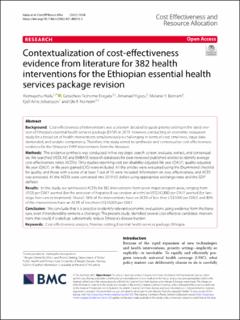| dc.description.abstract | Background
Cost-effectiveness of interventions was a criterion decided to guide priority setting in the latest revision of Ethiopia’s essential health services package (EHSP) in 2019. However, conducting an economic evaluation study for a broad set of health interventions simultaneously is challenging in terms of cost, timeliness, input data demanded, and analytic competency. Therefore, this study aimed to synthesize and contextualize cost-effectiveness evidence for the Ethiopian EHSP interventions from the literature.
Methods
The evidence synthesis was conducted in five key steps: search, screen, evaluate, extract, and contextualize. We searched MEDLINE and EMBASE research databases for peer-reviewed published articles to identify average cost-effectiveness ratios (ACERs). Only studies reporting cost per disability-adjusted life year (DALY), quality-adjusted life year (QALY), or life years gained (LYG) were included. All the articles were evaluated using the Drummond checklist for quality, and those with a score of at least 7 out of 10 were included. Information on cost, effectiveness, and ACER was extracted. All the ACERs were converted into 2019 US dollars using appropriate exchange rates and the GDP deflator.
Results
In this study, we synthesized ACERs for 382 interventions from seven major program areas, ranging from US$3 per DALY averted (for the provision of hepatitis B vaccination at birth) to US$242,880 per DALY averted (for late-stage liver cancer treatment). Overall, 56% of the interventions have an ACER of less than US$1000 per DALY, and 80% of the interventions have an ACER of less than US$10,000 per DALY.
Conclusion
We conclude that it is possible to identify relevant economic evaluations using evidence from the literature, even if transferability remains a challenge. The present study identified several cost-effective candidate interventions that could, if scaled up, substantially reduce Ethiopia’s disease burden. | en_US |

